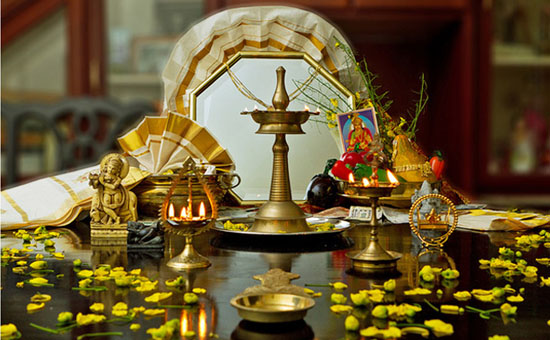Vishu falls on the first of the Malayalam month Medam
which corresponds to 14 or 15 of April. It marks the beginning of spring.
However, Nature is well ahead of time and
seems eager to receive spring is evident from the early blooming of Cassia fistula locally called Kanikonna.
By the end of January or early February, we can see Kanikonna with its golden yellow flowers around.
Vishu is
an agrarian festival. We Indians follow the tradition of performing or
conducting good deeds on auspicious time. All the agricultural practices
commence on the auspicious day called Njaattuvela,
which commences with Vishu. We know that there are 27 asterisms. The whole
calendar year when divided by 27 gives 13.5 days. Each phase is called Njattuvela which is named after the asterism
beginning with Aswathi. For example the first Njattuvela of Aswathi begins on the day of Vishu and ends on 26 of April. There are certain agricultural practices, which are to be performed on the beginning of each Njattuvela. They sow seeds on the prepared soil and the harvest will be reaped in Chingam, Malayalam New Year which corresponds to August-September. Thiruvonam falls in Chingam which is four months away. Vishu also indicates the movement of the Sun to Aries or the Mesha Rashi.
The
Celebration: On the
eve of Vishu, people will be busy buying the necessary articles or items for the occasion. The indispensable among this is preparation for arranging Vishukkani.
Kani in
Malayalam means the first thing you see when you wake up. On Vishu day special
Kani is arranged thus. On a platform, rice is filled in an Uruli (circular bronze vessel). Bunches of Kanikonna, fruits
like mango, plantain and Jack, cashew nuts, vegetables like cucumber called
Kani vellari, a length of jasmine, a hand mirror called Vall Kannadi, turmeric, kumkum, gold, currency or coins, a
length of silk, a piece of Manjamundu
(yellow cloth) and a Holy Book are arranged around the Uruli. The whole
Kani is positioned in front of an oil lit lamp and an idol of Lord
Krishna.
On the
Vishu day, at dawn, melodious voice of the Vishu Pakshi (the Indian cuckoo)
fills the air. This is the breeding
season of Cuckoo. It is mango season as well. Vishu Paskhi perched on the mango
tree keep on rendering in its sweet voice. The mother lights the lamp
and wakes up other members one by one. She stands behind and closes their eyes
with her palms and slowly leads them in front of Vishukani and takes off her
hands to let them behold the Kani.
After a
small prayer, the mother places a coin on the right hand. It is called Kaineettam. On receiving it the
family member, prostrate in full length. Then she brings the next member to
behold Kani. This is called Kanikaanuka. It is believed that Kanikaanal
would usher prosperity throughout the year. If there is any sick member in the
family, Kani is taken to them. It is also carried to the cowshed and the
courtyard where there are trees.
On this
day, whoever visits the house is given a coin of any denomination affordable to
the family. The servants are specially paid. People with whom daily
interactions are maintained as those who deliver milk, newspaper, vegetables,
collects garbage are given Kaineettam. After the ritualistic bath people visit
temples. What follows is a sumptuous feast for
lunch.
Vishukkani is arranged in all temples. People visit
the temple nearby to observe it. Vishukkani is popular in Guruvayur, Sabarimala
and Sree Padmanabhaswami Temple. So there are devotees who visit any of these
temples for Vishu. It is a holiday so they make a family trip to Guruvayur and
Sree Padmanabhaswami Temple.
The Vishukani timings are different in these three
temples. In Guruvayur: Vishukani darshan will be from 2.30 to 3 30
am. Sabarimalai specially reopens for Vishu. It remains open from 10th to
18th of April. The Vishukani darshan will be at 5 am.
At the Sree Padmanabhaswami Temple, a gold coin with
royal insignia will be handed over to the head priest on the previous day. It
will be part of Vishukani.
The Maharaja and other royal family members visit
the temple at 5 am. His Highness will be given the gold coin by the head
priest. Then they again visit the temple at 7.25 am for the routine darshan. At
the palace, Kaineettam will be given to people who are closely attached to the
royal family by the Maharaja himself.
Renowned poet Ayyappa Paniker on Kanikonna wrote: “Pookkathirikkan
enikkavathillaa” (I cannot but bloom) is a popular nostalgic verse which fills the mind of every Malayalee during Vishu.
Author is knowledgeable
on culture and history of Kerala and author of books on the subject.
To read other articles by author
To see
pictures of
1. Thrissur Pooram Festival
2. Elephants ornaments
